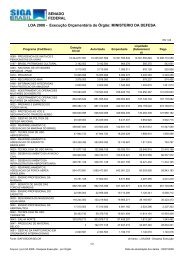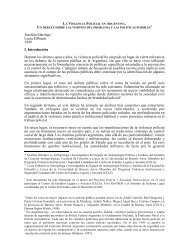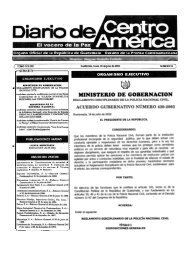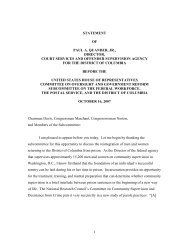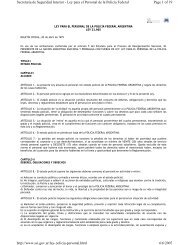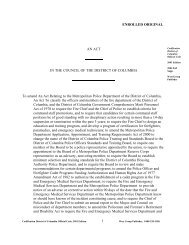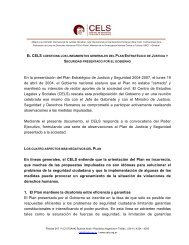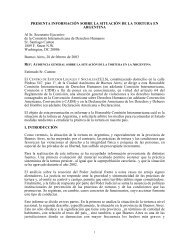Venezuela: The Life and Times of the Party System - Political ...
Venezuela: The Life and Times of the Party System - Political ...
Venezuela: The Life and Times of the Party System - Political ...
You also want an ePaper? Increase the reach of your titles
YUMPU automatically turns print PDFs into web optimized ePapers that Google loves.
<strong>The</strong> second point concerns <strong>the</strong> impact <strong>of</strong> <strong>the</strong> electoral system itself. <strong>The</strong> basic principles<br />
<strong>of</strong> <strong>the</strong> system were laid down in <strong>the</strong> trienio reforms <strong>and</strong> remained substantially unchanged until<br />
<strong>the</strong> late 1980s. <strong>The</strong>se include basic norms such as universal suffrage (all adults over 18), <strong>the</strong><br />
obligatory <strong>and</strong> secret character <strong>of</strong> <strong>the</strong> ballot, proportional representation for legislatures <strong>and</strong> only<br />
a relative majority for president, <strong>and</strong> <strong>the</strong> constitution <strong>of</strong> a strong, independent body to oversee<br />
elections <strong>and</strong> count votes (<strong>the</strong> Consejo Supremo Electoral). <strong>The</strong> voting system was designed to<br />
be simple <strong>and</strong> easy for a largely illiterate population to use. For example, <strong>the</strong> parties have long<br />
been identified with colors (white for AD, green for COPEI) a technique that reinforces <strong>the</strong> ease <strong>of</strong><br />
ballot choice. Several o<strong>the</strong>r features <strong>of</strong> <strong>the</strong> system are relevant here, most notably <strong>the</strong><br />
scheduling <strong>and</strong> integration <strong>of</strong> elections at all levels, <strong>the</strong> process <strong>of</strong> c<strong>and</strong>idate selection, <strong>and</strong> <strong>the</strong><br />
operation <strong>of</strong> proportional representation.<br />
Until 1979, when separate municipal elections were instituted, voting for public <strong>of</strong>fice in<br />
<strong>Venezuela</strong> occurred only once every five years. To cast a ballot, voters had to make two choices:<br />
one for president, by selecting or marking a large card with <strong>the</strong> appropriate party color or symbol;<br />
<strong>and</strong> ano<strong>the</strong>r by repeating <strong>the</strong> operation with a small card <strong>and</strong> <strong>the</strong>reby casting a vote for <strong>the</strong><br />
party’s slate for all legislative seats. This included c<strong>and</strong>idates for <strong>the</strong> Senate <strong>and</strong> Chamber <strong>of</strong><br />
Deputies on <strong>the</strong> national level <strong>and</strong> also for state legislative assemblies <strong>and</strong> municipal councils.<br />
Such an arrangement enhanced <strong>the</strong> power <strong>of</strong> nationally organized parties <strong>and</strong> national-level<br />
leadership to define issues, select c<strong>and</strong>idates, <strong>and</strong> control campaigns. Top leaders have long<br />
controlled c<strong>and</strong>idate selection completely, fixing <strong>the</strong> place each c<strong>and</strong>idate receives on <strong>the</strong> party’s<br />
slate. Because legislative seats are allocated by proportional representation, location on <strong>the</strong> list<br />
has been critical to election. <strong>The</strong> structure <strong>of</strong> voting centers attention on differences among <strong>the</strong><br />
parties: until recently <strong>the</strong> actual names <strong>of</strong> c<strong>and</strong>idates have been little known.<br />
<strong>The</strong> emergence <strong>of</strong> a system dominated by competition between two heterogeneous <strong>and</strong><br />
broadly similar political parties is not exclusively an artifact <strong>of</strong> <strong>the</strong> electoral system. <strong>The</strong> kind <strong>of</strong><br />
proportional representation used in <strong>Venezuela</strong> allocates seats with minimal distortion <strong>and</strong> makes<br />
it relatively easy for minor parties to gain some seats through a national quotient. Minor parties<br />
rely almost exclusively on such ‘additional seats’ for <strong>the</strong>ir representation, while AD <strong>and</strong> COPEI<br />
draw seats wholly from direct election (Tables 3 <strong>and</strong> 4).<br />
Successful joint domination by AD <strong>and</strong> COPEI is basically a result <strong>of</strong> <strong>the</strong> overall<br />
homogenization <strong>and</strong> nationalization <strong>of</strong> society <strong>and</strong> politics described earlier. <strong>The</strong> political impact<br />
<strong>of</strong> regionalism, for example, has all but disappeared. Through all <strong>the</strong> national elections held since<br />
1947, wherever AD was strong at <strong>the</strong> outset it has declined <strong>and</strong> <strong>the</strong>n rebounded; where it was<br />
weak it came up. <strong>The</strong> pattern holds in reverse for COPEI, with <strong>the</strong> result that each party’s vote is<br />
broadly similar in all regions, states, <strong>and</strong> territories. National influences dominate <strong>and</strong> vote<br />
swings are broadly similar in all areas: AD <strong>and</strong> COPEI compete evenly <strong>and</strong> in similar ways



